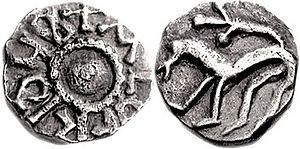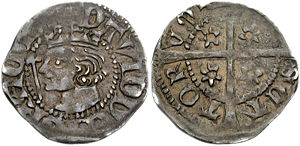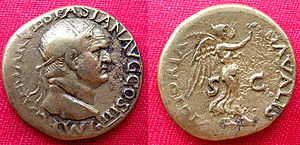- Scottish coinage
-
For coins circulating in Scotland since the Act of Union with England in 1707, see Coins of the pound sterling. For modern Scottish banknotes, see Scottish banknotes.
The coinage of Scotland covers a range of currency and coins in Scotland during Classical antiquity, the reign of ancient provincial kings, royal dynasties of the ancient Kingdom of Scotland and the later Mediaeval and Early modern periods.
Contents
Ancient History and Roman trade (ca 71–400 AD)
The earliest coins in Scotland were introduced by the Roman provinces of Britain that were obtained from trade with the westernmost outpost of the Rome. Far from being isolated, the Celts of Caledonia, north of Hadrian's Wall, developed trade to the general benefit of the population, to the north of the Wall.[1] Roman coins appear over a wide range across the country, especially sites near the Antonine Wall.[1] Hadrian's Wall was also regarded as a means to regulate social traffic and trade north, rather than a military defence against the free northern tribes of the Caledoni.[2] Civil settlements arose along south of the wall with shops and taverns that facilitated trade between the Empire and free north.[3] It is possible to recognise groupings of coins from certain periods, during the Flavian and Antonine occupations; e.g. Cardean Fort Angus where Roman dupondius coins AD 69–79 date to the reign of Emperor Vespasian.[1] Other sites include coins from North Uist dating to the 4th century until recently was though to be beyond the sphere of known trade routes.[4] Other native sites include the Fairy Knowe broch Buchlyvie, and the broch and dun at Gargunnock in Stirlingshire.[1] Some sites include substantial silver treasure hoards most likely buried or abandoned in either Roman or native pots.[5] Indicating the Roman governor of Britain paid large sums of money to the inhabitants of southern Scotland and possibly bribing the northern Caledonians to maitain peaceful relations. Payments to chieftains are recorded in four areas; Edinburgh, Fife, Aberdeen and the Moray Firth.[6] This may indicate such discoveries (e.g. the Birnie hoard of between 200–400 silver coins) were deposited as votive offerings.[6] Examples including coinage of Constantine II (337–342) with over 20 such hoards found throughout Scotland. Rare examples includes a base silver (potin) coin of Ptolemy XIII of Egypt, 80–51 BC[1] In AD 410, trade ceased as the Roman Empire withdrew from the island of Britain.
Early medieval period (500–900)

O: +ALDFRIDVS around central annulet. R: Left-facing quadruped. Silver sceat of Aldfrith of Northumbria, 685–704. As the Roman Empire retreated from Britain various kingdoms sprouted up to the south of Scotland.[7] One of these Northumbria, soon expanded into the north as far as the kingdom of Strathclyde. Thus it controlled the southern parts of what is now Scotland, and the bronze Sceat coins of the Northumbrian Kings circulated freely in what is now Scotland. This coin was issued from 837–854. Anglo-saxon coins were minted in Northumberland, however due to the extensive trade routes of the Vikings sceatt coins were also minted in Frisia and Jutland during Anglo-Saxon times and coins of this period indicate the extent of Scottish trade not only with Northumberland but also ith continental Europe. Norse also introduced some form of coinage, and coins from as far away as Byzantium and the Arabic countries have been found in sites in Scandinavia, including Norway which has strong links with Scotland in the early Middle Ages.
Scottish Crown (ca 1100–1600)
David II (1329–71): penny 
+DAVID DEI GRACIA, crowned head left; scepter before [REX] SCT TOR Vm+, long cross; mullets in quarters. 18mm; 1.31 g; circa 1351–57. The first king of Scots to produce his own coinage was David I (1124–53). David I has been regarded as an anglicising force in Scotland, and indeed, the coins bear an uncanny resemblance to those of Stephen, King of England. The Penny was minted at Berwick, and had his name as "Tavit". The reverse had a short cross with pellets in the four quarters. Later in his reign coins were minted in Berwick, Roxburgh and Edinburgh. By 1250, the country had no less than 16 mints, scattered from Inverness to Berwick. Later influences for Scottish coinage were the German speaking lands and France, both of which would contribute names such as "dollar" (Thaler), "testoun" (from French tête meaning head, on account of the portrait on it), and "merk" (or "mark").
In 1485, according to IH Stewart, the groat bore "the first real coin portrait to be seen north of the Alps".
During the 16th century, production of coinage moved entirely to Edinburgh, although Stirling produced one issue of bawbees.
Union of the Crowns (from 1603)
With the Union of the Crowns in 1603, Scottish coins became more closely based on English models, rather than Continental ones. At this period, it was still not uncommon for coins to be used in more than one country, partly because of their metal value. During the reign of Charles I, mechanical minting was introduced.
Following the union, James VI introduced the first gold coins that were similar on both sides of the border, with an exchange rate of 1 pound sterling to 12 pound Scots.[8]
1707–10 recoinage
Following the 1707 union between the Kingdom of Scotland and the Kingdom of England, the Scottish silver (but not gold nor copper) coinage was replaced with new silver coins, with the aim of creating a common currency for the new Kingdom of Great Britain as required by the Treaty of Union.[8] The exercise was conducted under the guidance of Sir Isaac Newton, who had previously directed the recoinage in England some years earlier in his role as Warden of the Mint (and subsequently as Master of the Mint).
Despite fluctuations in the exchange rate since 1603, and a 1697 proclamation setting the ratio at 13:1, a 12:1 ratio was applied to the recoinage, although compensation was paid. The new coinage was made using Troy weights (12 Troy ounces to the pound), rather than the traditional Scots weights (16 Troy ounces to the pound). Coins were minted in both London and Edinburgh, the latter inscribed with the letter 'E' under the bust of the monarch to permit them to be distinguished.[8] Under the supervision of moneyers from the Tower Mint in London, a weight of 103,346 pounds in crowns, half-crowns, shillings, and sixpences were minted at the Edinburgh Mint with a value of £320,372 and 12 shillings, [9] equivalent to US$18,588,700 (£10,129,200) at 2008 average silver prices and exchange rates.[10][11]
As a result of the recoinage, foreign coins, which were frequently used alongside the local currency, stopped being legal tender on 6 October 1707. Pre-Union 40, 20 and 10 shilling coins ceased to be legal tender on 10 February 1708, but were temporarily put back into circulation before finally ceasing as legal tender on June 1st, along with coins of ½, 1, 2, and 4 merks, 5 shillings, and the 3 shilling 6 pence coin.
The last batch of new coins, consisting of silver shillings and half-crowns were delivered on 5 October 1709, and were to be the last coins to be minted in Scotland.[8]
Subsequent developments
Article 16 of the Treaty of Union stipulated that Scotland was to keep its own mint, but this, as with many others, has not been followed.
"That, from and after the Union, the coin shall be of the same standard and value throughout the United Kingdom as now in England, and a Mint shell be continued in Scotland under the same rules as the Mint in England ; and the present officers of the Mint continued subject to such regulations and alterations as Her Majestie, her heirs or successors, or the Parliament of Great Britain shall think fit."—Article XVI of the Acts of Union[12]Although the Edinburgh Mint retained its permanent officials (though not other staff) for a further hundred years, until 1814, minting ceased a mere two years after Union, despite several subsequent proposals to restart production. The mint itself was finally abolished in 1817 and sold in 1830.[13] Abolition caused a low level of protest, mentioned by Sir Walter Scott, and continued to be protested against by Nationalist pamphlets into the 1950s and beyond. The title of 'Governor of the Mint of Scotland', which passed to the Chancellor of the Exchequer under the Coinage Act 1870, was finally abolished with the passing of the Coinage Act 1971.[13]
The transition from Scottish coinage to English did not occur overnight. Scottish coinage was still in circulation in the later 18th century, but the changeover was made a little easier due to common currency in the nomenclature. Pound Sterling is still translated as Punnd Sasannach (English pound) in Scottish Gaelic [14] Certain old coin names, such as bawbee,[15] continued in colloquial usage into the 20th century. Others, such as mark and dollar, would be more associated with various foreign currencies by contemporary Scots.
Currently, three Scottish banks produce their own banknotes (Bank of Scotland, Royal Bank of Scotland and Clydesdale Bank), but no coinage. Scotland is the only part of the UK where one pound notes are still in usage (although they can be found in the Isle of Man and Channel Islands).
List of Scottish coins
Mary (1542–67), Francis (1558–60): testoon 
FR•AN • ET • MA • D • G • R • R • SCOTORVM • D • D • VIE[N], crowned arms of Francis and Mary over cross potent • FECIT • VTRAQVE • VNVM • 1558 •, crowned FM; Lorraine cross to either side. As with Scottish weights and measures, many of the Scottish denominations bore the same names as those in England, but were of slightly different values. The dates, and first kings to issue them are included:
- Pistole – Gold, 12 pounds Scots
- Dollar – Replacement for the ryal, 60 Scots shillings (James VI)
- Ryal – Gold, 1565
- Crown or Lion – Gold (James I)
- Half-crown, Demi-Lion or Demys – Gold (James I)
- Ducat or “bonnet” – 40 shillings, 1539 (James V)
- Mark or merk – Gold (giving rise to the term markland)
- Noble – Gold, worth half a mark, 1357 (David II, reintroduced by Robert III)
- Unicorn - Gold, 18 shillings Scots, 1484/5 (James III)
- Half-unicorn - Gold, 9 shillings Scots (James IV)
- Testoun – silver, 1553. Was produced in France with the new process of mill and screw, being the first milled coinage of Scotland.[16]
- Bawbee – Billon, six pence from 1537
- Shilling
- Groat – Silver, equivalent to four pence, from 1357 (giving rise to the term groatland)
- Half-groat – Silver, equivalent to two pence, from 1357
- Turner – Billon, two pence (James VI), later copper.
- Bodle – Copper, two pence (Charles II)
- Hardhead – also called Lion, billon coin circulated in the reigns of Mary and James VI
- Penny – Billon, one of the earliest coins, dating from David I. Later made of copper; giving rise to the term pennyland.
- Halfpennies – Initially literally half of a penny, these became minted coins in their own right in c.1280. Later made of copper.
- Farthing or quarter-penny – These were originally quarters of pennies, but as with Halfpennies, became coins in their own right in c.1280. Later made of copper.
- Plack
Scottish monarchs who issued coins
- David I (1124–53)
- Malcolm IV (1153–65)
- William the Lion (1165–14)
- Alexander II (1214–49)
- Alexander III (1249–86)
- John Balliol (1292–96)
- Robert the Bruce (1306–29)
- David II (1329–71)
- Robert II (1371–90)
- Robert III (1390–1406)
- James I (1406–37)
- James II (1437–60)
- James III (1460–88)
- James IV (1488–1513)
- James V (1513–42)
- Mary, Queen of Scots (1542–67)
- James VI (1567–1625)
- Charles I (1625–49)
- Charles II (1660–85)
- James VII (1685–88)
- William and Mary (1689–94)
- William II (1694–1701)
- Anne (1701–14, no coins minted after Union)
Notes
- ^ a b c d e Roman coins found in Scotland, 1971–82 by Anne S. Robertson
- ^ Celtic culture: a historical encyclopedia, Volumes 1–5 By John T. Koch
- ^ Borders and border politics in a globalizing world By Paul Ganster, David E. Lorey
- ^ Ancient coins discovered on beach, BBC News Online, 12 July 2007
- ^ Bribing the Barbarians, National Museums Scotland
- ^ a b Romans paid Scots protection money, The Independent, 3 November 2000. Retrieved 18 December 2000
- ^ Robinson, Christine (2003), Get set for English language, Edinburgh University Press, p. 62, ISBN 9780748615445
- ^ a b c d Sir Isaac Newton and the Scottish recoinage, 1707–10, Athol L Murray, Society of Antiquaries of Scotland, 1997
- ^ Notes on a collection of coining instruments in the National Museum of Antiquities, Edinburgh, J W Hocking, Curator and Librarian of the Royal Mint.
- ^ Price History: 2000 to Present, The Silver Institute
- ^ http://www.oanda.com
- ^ Stewart: The Scottish Coinage, p. 120 & ff.
- ^ a b The Scottish Mint after the recoinage, 1709–1836, Athol L Murray, Society of Antiquaries of Scotland, 1999
- ^ The Scottish Gaelic Column, Scottish Radiance
- ^ Bawbee, Dictionary of Phrase and Fable, E. Cobham Brewer, 1894
- ^ Stewart: The Scottish Coinage
References and further reading
- Donald Bateson. Scottish Coins. Shire Book, Bucks, 1987, ISBN 0-85263-847-7
- Jean Belaubre. Dictionaire de Numismatique médiévale occidentale. Paris, Léopard d'Or, 1996. ISBN 2-86377-121-3
- Holmes, Nicholas, Scottish Coins, NMS Publishing, Edinburgh (1998), ISBN 1-901663-02-7
- Mackay – Mussel (eds.): Coin Price Guide to British coins 1066- Token Publishing Ltd, Axminster, Devon ([1])
- Ian Halley Stewart. The Scottish Coinage, Spink & Son, London, 1955
- "Coinage" – in Collins Encyclopedia of Scotland (ed. Keay & Keay, 1994)
See also
- Pound Scots
- Modern Scottish banknotes
External links
- Scottish coins until 1707
- Scottish Coins 1136–1707
- Digital Library Numis Online books and articles on Scottish coinage
 Scotland topics
Scotland topicsHistory Geography Geology · Climate · Demographics · Mountains and hills · Islands · Lochs · Waterfalls · Fauna · Flora · Highlands · Lowlands · Central Belt · Anglo-Scottish borderEconomy Companies · Bank of Scotland · Royal Bank of Scotland · North Sea oil · Whisky · Tourism · Harris Tweed · Renewable energy · Transport · Saltire FoundationLaw People Politics Religion Languages Culture Clans · Cuisine · Education · Flags · Coat of arms · Anthem · Hogmanay · Innovations · Literature · Music · Sport · World Heritage Sites · National identity · National symbols · Scottish surnamesCategories:- Currencies of Scotland
- Economic history of Scotland
- Coins of Scotland
Wikimedia Foundation. 2010.

